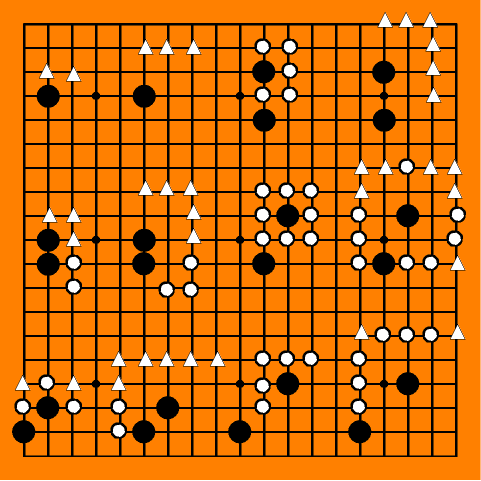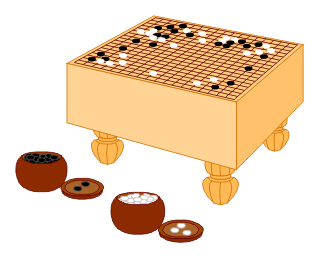GO In The West
BADUK In Korea
IGO In Japan
WEIQI In China
© Craig R. Hutchinson, 18 February 2007

A Contest of
Life, Liberty and the Pursuit of Happiness
A Application with Many Principles.
A Language with Many Words.
A Action with Many Choices.
A Study with Many Patterns.
A Puzzle with Many Tricks.
A Trade with Many Values.
A Craft with Many Shapes.
A Dance with Many Steps.
A War with Many Battles.
A Art with Many Forms.
A Life with Many Ideas.
Enjoy Your Good Premises!
AN INTRODUCTION TO THE ART OF GO
A professional Go player,
like a painter or a poet,
is a maker of shapes.
If their shapes are more permanent than amateur Go players,
it is because they are made with ideas.
The Go player's ideas,
like the painter's or the poet's,
must, like colors or the words,
fit together in a harmonious way.
Beauty (harmonious ideas, strategies, & tactics) is the first test,
for there is no permanent place in the world for ugly Go.
The art of Go,
a language of shapes,
often proves to be very difficult
to put into practice for amateurs.
With their limited playing experience,
they cannot conceive where the difficulties lie
and what the grand masters accomplish.
Everything is simple in Go,
but the simplest thing is difficult.
These difficulties accumulate and produce a complexity
which no one who has not played Go can really imagine.
Go, as a language, is not an exact science
since it contains a great drama full of passion
in which a thousand physical and mental causes operate,
and thus cannot be reduced to mathematical calculations.
Therefore, the first of all prerequisites
for a player's success is to be perfectly calm.
The calculation of plays (time) and territory (space)
is the foundation of strategy and tactics,
and the calculations are
the most difficult and most decisive elements.
Also, the correct judgment of their opponents,
the audacity to leave only a small force before them,
boldness in sudden attacks,
and the intensified activity
which great souls acquire in the moment of danger,
win victories.
Boldness, directed by an overruling intelligence,
is the mark of the winner.
The art of Go is in itself very simple
and requires nothing more than
ordinary intelligence and careful consideration.
Notwithstanding its simplicity,
amateur and many professional players
have difficulty in grasping it thoroughly.
Their minds wander off to accessory details
instead of fixing themselves on first causes
because of Go's versatile language.
The amateur can be in a constant whirlpool
of true and false information,
of mistakes committed through fear,
negligence or haste,
and is a victim of many plays,
most of which are intimidating
and few of which are encouraging.
Through long experience in playing Go,
one acquires the sensitive perception
necessary for quickly determining
the true value of a play.
Further, there is hardly any celebrated accomplishment in Go
which was not achieved by an endless series of trials and errors,
and as such,
only an immense force of will can conduct one to their goal.
Thus to reach the master level
a player requires
intelligence, perseverance, and judgment
as well as technical competence.
Two very different talents must exist in amateur players
to make them professional players:
first, they must know how to arrange a flexible,
strategic campaign and operational plans based on strategy;
and second, they must be able to carry them
to a successful termination using tactics.
The first talent depends more on individual character,
is a personal attribute, and can be created and/or improved
by studying shapes and their vital points.
The second talent may be a natural gift,
but it also can be acquired and/or developed
by studying shapes and vital their points.
It is difficult to develop a theory of Go
that would cover all cases.
Present theories of Go concentrate upon the material forces,
disregarding the fact that the entire game
is permeated by psychological forces.
They consider only the activity of one side,
but Go is a constant state of reciprocal action
in which your plans (strategic, campaign and operational)
may always be upset by your opponents reaction.
The player must act according to the situation
and not according to any particular theory;
however, a player can use theory in studying the art of Go
for self-instruction guidance.
In addition, a player should remember that Go is like a language.
Each game of Go has its own special character;
it reflects the knowledge and psychological conditions of its time;
and in order to draw worthwhile lessons from a game,
the player must understand the conditions
under which it was fought.
Critical study of any game involves thorough historical research
to determine what actually happened;
therefore, the causes of the various results
must be determined to learn why.
With these factors determined,
theories may be developed to explain the overall action,
and praise or censure awarded.
What a professional does must be the best of all principles,
and theory cannot do better than to show how or why.
Strategy is the art of maneuvering the formations on the Go grid,
and tactics is the art of placing them upon the Go grid.
There is but one goal underlying the strategy and tactics in Go:
to concentrate the formations of one's stones
upon the decisive point at the critical time.
In accomplishing this goal,
strategy involves integrating the following war principles:
Objective, Offensive,
Mass, Economy,
Maneuver, Simplicity,
Surprise, Security,
Unity.
The usefulness of such principles depends on
the difficulty of recognizing the decisive points and critical times
for applying the principles under the stress of play.
The strategic principles themselves are simple,
common sense, and easy to understand;
but the difficult part of Go is their application
in the allowed time to play,
requiring much study
and the attitude and temperament
of a professional to master the game.
For example, the principle of maneuver
is governed by a number of maxims.
One maxim is to obtain by free and rapid movements
the advantage of bringing the formations of stones
against factions of the hostile stones.
Another maxim is to strike in the most decisive direction i.e.,
in that direction where the consequences
of the tactical defeat of your opponent
may be most strategically disastrous,
while at the same time
any tactical success your opponent might gain
would yield the least possible strategic advantage.
One application of the strategic principles is as follows.
If you have twenty stones
against an equal number of your opponent's,
you may use the strategic principles
to enable you to bring to your main attack,
at the decisive point
where the important decision is to take place,
sixteen of your stones against ten of your opponent's
while employing the remaining four in a supporting attack
to contain the other half of your opponent's stones.
Another example of the strategic principles
is that too close a pursuit of a group of stones
over the entire grid
contains the seeds of its own destruction.
The pursuing stones would soon be weakened
by "strategic consumption", i.e.,
the lengthening of its line of communication,
the necessity of making numerous detachments
to secure its rear and cover its flanks,
and constant losses from minor actions.
Thus continually weakened,
the pursuer sooner or later
would become vulnerable to a counteroffensive.
Beyond the culminating point, the scale turns;
and the violence of the recoil is commonly much greater
than was that of the forward push.
Players can hope for success only if,
despite the effects of strategic consumption,
their stones remain stronger than their opponent's.
Thus, the game of Go must be considered as a whole
where minor victories have no value
except as they contribute to the main strategic effort.
It may be easy to determine
the decisive point of a game or local battle,
but not so easy to determine
the decisive moment;
and it is precisely here
that professional experience is everything,
and mere theory of little value.
A good library is indispensable
as it has the advantage of being more lasting
than the genius of a single mind.
In addition, it can remedy many evils
as it will tend to prevent mistakes
by furnishing the player with reliable information.
Correct theories and proverbs,
founded upon proper principles,
sustained by actual events in Go,
and added to accurate Go history,
will form a true school of instruction for amateurs.
Moreover, if these means do not produce great players,
they will at least produce players of sufficient skill
to take rank next to the natural masters of the art of Go.
Please study a few grandmaster games in detail,
and enjoy the Go
Elements, Principles, State Esteem, Proverbs, Art.
Aesthetics/Refined/Tactfulness
The adept strategical and tactical
shape maneuvers on the Go grid!
Enjoy Your Good Premises!
NAME THE SHAPES

What names do you use for the above shapes?
One set of names is given below.
These shapes are also unstable liberty shapes for a base.
SHAPE NAMES

Here are some names that are in use for the above shapes
to help your visualization of what is happening on the grid.
B: Bud, Square Four;
C: Coffin;
G: Sloth, Log, Straight Three;
H: Hat, Pyramid, T-Four;
K: Knife, Knife Five, Cleaver;
L: Lamb, L;
M: Mouse, Bent Three;
R: Flower, Rabbit, Grape Six;
S: Star, Flower Five;
T: Step
MORE INFORMATION
Go Art is an introduction to the art of Go
for learning one of this planet's oldest active board games, called called Go in the West,
Baduk in Korea,
Igo in Japan,
and WeiQi in China.
For more information about
Go, Baduk, Igo, or WeiQi players and clubs in your area,
or on the Internet, contact:
The American Go Association
PO Box 397, Old Chelsea Station
New York City, NY 10113-0397
E-mail: membership@usgo.org
Net: www.usgo.org
or contact Hutch
Phone: 703-698-9811
E-mail: crhutch@erols.com
Net: http://users.erols.com/crhutch/go.html
To obtain books and equipment, contact:
Ishi Press
Phone: 800-859-2086
E-mail: IshiPress@aol.com
Net: http://www.ishigames.com
Kiseido
Phone: 800-988-6463
E-mail: kiseido@yk.rim
Net: www.kiseido.com
Samarkand
Phone: 800-600-4373
E-mail: info@samarkand.net
Net: www.samarkand.net
Slate & Shell
Phone: 800-653-7640
E-mail: bcobb@slateandshell.com
Net: www.slateandshell.com
Yutopian Enterprises
Phone: 800-988-6463
E-mail: sales@yutopian.com
Net: www.yutopian.com
